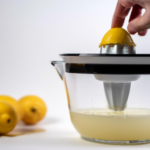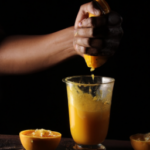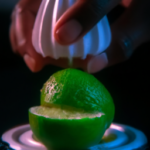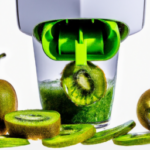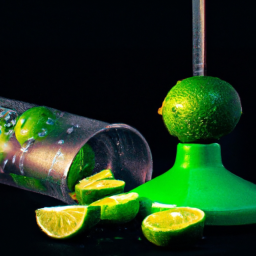Juicing offers a nutritious and tasty option to enjoy fruits and vegetables. Nonetheless, not all individuals own a juicer in their homes. Yet, there’s no need to worry, as there are numerous methods to prepare juice even without the presence of a juicer.
In this article, I will share with you some of the methods I have tried and found to be effective in making juice without a juicer. Juicing without a juicer may seem daunting at first, but it is actually quite simple. All you need is some basic kitchen equipment and a little bit of patience.
By using a blender, citrus juicer, food processor, fork or potato masher, or grater, you can make fresh juice from your favorite fruits and vegetables in no time. So, let’s dive into the world of juicing without a juicer and discover the different techniques and tips that will help you make delicious and nutritious juice at home.
Key Takeaways
- There are several methods for making juice without a juicer, including using a blender, citrus juicer, food processor, fork or potato masher, and grating.
- Making juice at home allows for customization of ingredients and avoids added preservatives or artificial flavors.
- High water content fruits are best for hand juicing, and ripe fruits are easier to juice and have a sweeter taste.
- Homemade juice shelf life depends on the type of produce and whether or not it has been pasteurized, but can be extended by storing in an airtight container and refrigerating or adding lemon juice or citric acid.
Using a Blender
If you don’t have a juicer, don’t worry – using a blender is a great alternative that allows you to still reap all the nutritious benefits of fruits and vegetables.
There are several blender alternatives that you can use to create your juice, such as a high-speed blender or a regular kitchen blender with a powerful motor. High-speed blenders are preferred because they can easily break down the fiber in fruits and vegetables, resulting in a smoother consistency and better absorption of nutrients.
When using a blender, it’s important to use the right blending techniques to ensure a high-quality juice. Start by adding a small amount of water to the blender to help the fruits and vegetables blend together.
Next, add your chosen fruits and vegetables, making sure to chop them into smaller pieces to make the blending process easier.
Lastly, blend on high speed for a few minutes until the mixture is smooth.
Once you’ve blended your juice, you can strain it to remove any pulp or fiber that may be left behind. If you prefer a pulpier juice, you can skip the straining process altogether. However, if you’re looking for a smoother consistency, straining your juice is necessary.
Now that you know how to make juice using a blender, let’s move onto the next section on using a citrus juicer.
Using a Citrus Juicer
Using a citrus juicer is as easy as slicing through butter with a hot knife. Here are the steps to follow for a successful juicing experience:
-
Choose the right citrus fruit: the best ones to use are oranges, lemons, limes, and grapefruits. Make sure they’re fresh and bright in color.
-
Cut the fruit in half and remove any seeds: use a sharp knife to cut the fruit in half, and then use a spoon or a citrus reamer to remove any seeds.
-
Place the fruit on the juicer: put the fruit half on the juicer with the cut side facing down.
-
Press down and twist: apply pressure on the fruit while twisting it back and forth, until all the juice is extracted.
-
Cleaning Tips: after juicing, make sure to clean the juicer thoroughly to avoid any buildup. You can use warm soapy water or even put it in the dishwasher.
When using a citrus juicer, it’s important to remember that not all fruits are created equal. Some citrus fruits may be too sour or too sweet, which can affect the taste of the juice. Therefore, it’s important to choose the right citrus fruit to get the desired taste.
Once done, you can move on to the next step of making juice using a food processor.
Using a food processor is another great way to make juice without a juicer.
Using a Food Processor
Get ready to experience the purest and most delicious flavors of your favorite fruits with this effortless kitchen hack – using a food processor for your homemade beverages! If you don’t have a juicer at home, a food processor can be a great alternative. It’s a versatile tool that can help you make a wide variety of fruit juices, smoothies, and purees.
When using a food processor for juicing, it’s important to choose the right fruits. Some of the best fruits for food processor juicing include berries, melons, citrus fruits, and apples. These fruits have a high water content and are easy to process in a food processor. Simply chop them into small pieces and add them to the food processor. Pulse on high speed for 1-2 minutes until the fruits are pureed. You can then strain the juice through a fine mesh sieve to remove any pulp or seeds.
Using a fork or potato masher is another great alternative to make juice without a juicer. Simply mash the fruits until they release their juices and then strain them through a fine mesh sieve.
With these simple kitchen hacks, you’ll be able to enjoy fresh and delicious fruit juices anytime!
Using a Fork or Potato Masher
You can easily transform your fresh fruits into a refreshing and healthy drink with just a fork or potato masher, using the fruit smashing or fork method. This technique is perfect for those who don’t own a juicer or blender, but still want to enjoy a glass of fresh juice.
Here’s how to do it:
- Choose your fruit: Select your favorite fruit or a combination of fruits that you want to use for your juice. Wash them thoroughly to remove any dirt or residue.
- Mash the fruit: Using a fork or potato masher, start mashing the fruit in a bowl until it turns into a pulpy consistency. This process may take some time, but it’s worth it.
Tips:
- To make the mashing process easier, you can chop the fruits into small pieces before mashing.
- You can also add a small amount of water to help the mashing process.
Once you have mashed the fruits to your desired consistency, you can strain the juice using a fine mesh strainer or cheesecloth. The resulting juice may have some pulp, but it will still be nutritious and tasty.
Now, let’s move on to the next subtopic – using a grater.
Using a Grater
When looking to add a bit of zest to your morning routine, grating fresh citrus fruits such as lemons, limes, or oranges can provide a burst of flavor and nutrition to your day. Grating techniques involve using the small, sharp holes on a grater to shred the fruit into fine pieces, releasing the juices and oils. This technique is especially useful for fruits that have a tough outer skin or are difficult to juice with a hand-held citrus juicer.
Some other fruits that are suitable for grating include apples, pears, and ginger. When grating these fruits, it’s important to use a fine grater to ensure that the fibers and pulp are broken down enough to release the juices.
Grated fruits can be added to water, tea, or even smoothies for an added burst of flavor and nutrition. Incorporating grated fruits into your morning routine is a great way to start your day off on the right foot. However, if you’re looking for a more traditional juice experience, there are several tips for making juice without a juicer that can help you achieve that fresh, delicious taste.
Tips for Making Juice Without a Juicer
One alternative method to using a juicer is to blend fruits and strain the mixture through cheesecloth. This process involves blending the fruits until they’re fully pureed, then pouring the mixture over a cheesecloth and squeezing out the juice.
This method can yield up to 30% more juice than juicing alone, making it a cost-effective option for those who don’t have a juicer at home.
When it comes to choosing the best fruits for hand juicing, it’s important to select those with high water content, such as citrus fruits, watermelon, and cucumbers. These fruits are easy to squeeze and will produce more juice than denser fruits like apples or pears.
Additionally, it’s best to choose ripe fruits as they’ll be easier to juice and will have a sweeter taste.
Overall, alternative methods like blending and hand juicing can be a great way to make juice at home without the need for a juicer, and can result in a more nutritious and cost-effective option.
By making juice at home, you can enjoy the benefits of fresh, natural juices without any added preservatives or artificial flavors. Plus, making juice at home allows you to customize the ingredients to your liking, adding in your favorite fruits and vegetables for a personalized blend.
Ultimately, whether you choose to use a juicer, hand juicing, or blending, making your own juice at home can be a fun and healthy way to stay hydrated and nourished.
Benefits of Making Juice at Home
I’m often asked if it’s possible to make juice without any tools. The answer is yes! There are many ways to extract juice from fruits and vegetables without a juicer, such as using a blender or a cheesecloth.
Another question that often comes up is how long homemade juice lasts. The shelf life of juice depends on a few factors, such as the type of produce used and whether or not it’s been pasteurized.
Finally, many people wonder if it’s possible to make green juice without a juicer. The answer is also yes! Blending leafy greens with a high-speed blender can yield a delicious and nutritious green juice.
Can I make juice without any tools?
You don’t need any tools to make juice, just your hands and a few ingredients. Mashing and squeezing fruits and vegetables by hand can provide a great way to make juice without a juicer. Making fruit smoothies and muddling fruits for cocktails are some examples of how to extract juice from fruits without any fancy equipment.
Using your hands to extract juice from fruits and vegetables has been a traditional method for centuries. It’s a simple yet effective way to make juice. Mashing and squeezing the fruits and vegetables by your hands can provide a great way to get all the nutrients and flavors from the produce.
However, this method can be time-consuming and may not extract as much juice as a juicer would. Now that we know how to make juice without any tools, let’s discuss how long homemade juice can last.
How long does homemade juice last?
Imagine you’ve just finished creating your own delicious blend of fresh fruits and vegetables, but you’re not sure how long it will last in the fridge. Well, the answer depends on a few factors such as the type of fruits or vegetables used, the storage conditions, and whether or not you’ve added any preservatives.
Generally speaking, homemade juice can last anywhere from 24 hours to 5 days when stored properly. To extend the shelf life of your homemade juice, it’s important to store it in an airtight container and keep it refrigerated at all times. Glass jars with tight-fitting lids or plastic containers with snap-on lids work well for this purpose.
Additionally, adding a small amount of lemon juice or citric acid to your juice can help preserve it for a few extra days. However, keep in mind that the longer you store your juice, the more its nutritional value will decrease.
Now, onto the next question – can I make green juice without a juicer? Well, the answer is yes!
Can I make green juice without a juicer?
In my previous subtopic, we talked about how long homemade juice can last. Now, let’s move on to the question of whether you can make green juice without a juicer. The answer is yes, you can definitely make green juice without a juicer.
In fact, there are many ways to make green juice at home without investing in a juicer. Before we dive into the different methods, let’s quickly discuss the benefits of green juice. Green juice is an excellent way to incorporate more vegetables into your diet. It’s packed with essential vitamins, minerals, and antioxidants that are necessary for a healthy body. Drinking green juice regularly can help boost your immune system, improve digestion, and increase energy levels.
Now, when it comes to making green juice without a juicer, there are a few methods you can try. Some of the best green juice recipes include using a blender, a nut milk bag, or a cheesecloth. These methods allow you to extract the juice from leafy greens, such as kale, spinach, and collard greens, without a juicer. So, if you’re looking to incorporate more green juice into your diet but don’t have a juicer, don’t fret. There are plenty of options available to you.
Frequently Asked Questions
Can I use frozen fruits and vegetables to make juice without a juicer?
Using frozen fruits and vegetables in homemade juice can be beneficial as they retain their nutrients and are convenient. To achieve maximum flavor, use a blender or food processor and add a bit of water or citrus juice.
How long can I store homemade juice without a juicer?
To store homemade juice without a juicer, it’s important to use clean equipment and sterilized containers. Keep the juice refrigerated and consume within two to three days to maximize shelf life.
Are there any fruits or vegetables that shouldn’t be used for juicing without a juicer?
When it comes to juicing safety, it’s important to choose the best fruits and veggies for hand juicing. Avoid using tough or fibrous produce like pineapples or ginger, and stick to softer fruits like berries and citrus.
How do I adjust the consistency of the juice made without a juicer?
To adjust the consistency of homemade juice, I recommend adding water or ice cubes to thin it out or blending in additional fruits or vegetables to thicken it. Flavor infusion options include herbs, spices, and citrus zest.
Can I use a coffee filter or cheesecloth to strain the juice?
Alternative straining methods for juice without a juicer include using a coffee filter or cheesecloth. The pros of using these methods are that they are inexpensive and easily accessible. However, the cons are that they may not effectively strain out all pulp and can be time-consuming.
Conclusion
In conclusion, making juice without a juicer isn’t just possible, it’s easy and fun. Whether you use a blender, a citrus juicer, a food processor, a fork or potato masher, or a grater, the process is simple and straightforward.
By following the tips and tricks outlined in this article, you can create delicious and nutritious juice at home without having to invest in expensive equipment.
Moreover, the benefits of making juice at home are numerous. You get to customize your juice to your taste and preferences, and you also get to control the quality and freshness of the ingredients.
Homemade juice is free from preservatives, additives, and artificial flavors, and it’s packed with vitamins, minerals, and antioxidants. By making your own juice, you can improve your health, boost your energy, and enjoy the natural flavors of fruits and vegetables.
So go ahead and try making juice without a juicer. Discover the joys of homemade goodness!
Ilana has been a vegan for over 10 years. She originally made the switch for health reasons, but soon found herself becoming more and more passionate about the ethical and environmental implications of a vegan lifestyle. Ilana is the author of The Graceful Kitchen, a blog all about veganism. She loves to cook up delicious and nutritious vegan meals, and share her recipes with others who are interested in leading a cruelty-free life. Ilana is also a strong advocate for using whole foods as the foundation of a healthy diet, and believes that going vegan is one of the best ways to achieve this.




